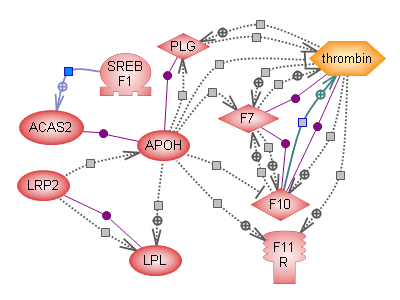Entrez 350 | Ensembl ENSG00000091583 | |
 | ||
Aliases APOH, B2G1, B2GP1, BG, apolipoprotein H External IDs OMIM: 138700 MGI: 88058 HomoloGene: 26 GeneCards: APOH | ||
Gene music using protein sequence of apoh apolipoprotein h beta 2 glycoprotein i
Apolipoprotein H (Apo-H), previously known as (β2-glycoprotein I, beta-2 glycoprotein I), is a 38 kDa multifunctional apolipoprotein that in humans is encoded by the APOH gene. One of its functions is to bind cardiolipin. When bound the structure of cardiolipin and Apo-H both undergo large changes in structure. Within the structure of Apo-H is a stretch of positively charged amino acids, (protein sequence positions 282-287) Lys-Asn-Lys-Glu-Lys-Lys, are involved in phospholipid binding (See image on right).
Contents
- Gene music using protein sequence of apoh apolipoprotein h beta 2 glycoprotein i
- Inhibitory activities
- Pathology
- Sushi 2 protein domain
- Structure
- Function
- References
Apo-H has a complex involvement in agglutination, it appears to alter Adenosine diphosphate (ADP) mediated agglutination of platelets. Normally Apo-H assumes an anti-coagulation activity in serum (by inhibiting coagulation factors), however changes in blood factors can result of a reversal of that activity.
Inhibitory activities
Apo-H appears to completely inhibit serotonin release by the platelets and prevents subsequent waves of the ADP-induced aggregation. The activity of Apo-H appears to involve the binding of agglutinating, negatively charged compounds, and inhibits agglutination by the contact activation of the intrinsic blood coagulation pathway. Apo-H causes a reduction of the prothrombinase binding sites on platelets and reduces the activation caused by collagen when thrombin is present at physiological serum concentrations of Apo-H suggesting a regulatory role of Apo-H in coagulation.
Apo-H also inhibits the generation of factor Xa in the presence of platelets. Apo-H also inhibits that activation of factor XIIa.
In addition, Apo-H inhibits the activation of protein C blocking its activity on phosphatidylserine:phosphatidylcholine vesicles however once protein C is activated, Apo-H fails to inhibit activity. Since protein C is involved in factor Va degradation Apo-H indirectly inhibits the degradation of factor Va. This inhibitory activity was diminished by adding phospholipids suggesting the Apo-H inhibition of protein C is phospholipid competitive. This indicates that under certain conditions Apo-H takes on a procoagulation properties.
Pathology
Anti-cardiolipin antibodies are found in both infectious (syphilis) and autoimmune disease (sclerosis, lupus). The activity of anti-cardiolipin antibodies in autoimmune antiphospholipid syndrome requires apolipoprotein H. The subset of antibodies that bind Apo-H and alter its activity are considered different from antibodies that bind thrombin, serum phospholipids and are called anti-apolipoprotein antibodies. In autoimmune disease, anti-apolipoprotein antibodies (Anti β2 glycoprotein I antibodies) strongly associate with thrombotic forms of lupus and sclerosis.
Sushi 2 protein domain
In molecular biology, the protein domain Sushi 2 is also known as the fifth protein domain of beta-2-glycoprotein-1 (b2GP-1). This protein domain is only found in eukaryotes. The first four domains found in Apolipoprotein H resemble each other, however the fifth one appears to be different.
Structure
This protein domain is composed of four well-defined anti-parallel beta-strands and two short alpha-helices, as well as a long highly flexible loop. Additionally, the fifth protein domain appears to resemble the other four in Apolipoprotein with the exception of three internal disulfide bonds and an extra C-terminal loop.
Function
Its exact function remains to be fully elucidated, however it is known to play an important role in the binding of b2GP-1 to negatively charged compounds and subsequent capture for binding of anti-b2GP-1 antibodies. Problems such as a mutation in this protein would lead to Antiphospholipid syndrome which often leads to pregnancy complications.
